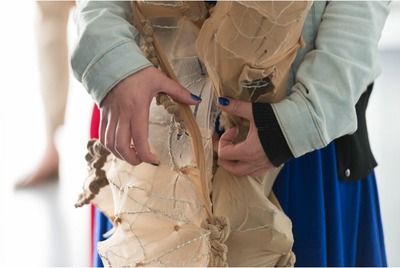Kidd, N and Addison, J (2016) By instruction: 'No Working Title'... Misunderstanding, misinterpretation, failure and disappointment. The unstable intersection between what is instructed and how it is interpreted. In: The Hidden Curriculum: Annual Symposium for Fine Art Educators, 22 January 2016, London Metropolitan University, London.
![By instruction: 'No Working Title' [thumbnail of By instruction: 'No Working Title']](https://researchspace.bathspa.ac.uk/7380/2.hassmallThumbnailVersion/NWT2015%202.jpg)  Preview |
Image (By instruction: 'No Working Title')
NWT2015 2.jpg Download (75kB) | Preview |
Abstract
This presentation by Natasha Kidd (Course Leader of the BA Fine Art course at Bath School of Art) and Jo Addison (Course Leader of the BA Fine Art course at Kingston University) offered an over view of 'No Working Title', a collaborative project between BA students and staff from 4 UK Art Schools that culminates in an event at Tate Modern. Since the 1960’s artists have been inventing or adopting rules, systems and strategies as a way of generating artworks. Often removing the execution of the artwork from the hand of the artist himself artists such as Sol Lewitt, Alghiero Boetti, Vito Acconci, Douglas Huebler, John Baldessari and Fluxus have not only challenged the status of the art object but questioned the role of the artist as author. In 2009, following this framework 'No Working Title' (NWT) was devised. This project sets out to provoke a dialogue between students and staff across 4 HE institutions, establish a collaborative relationship between the students and staff from these institutions and an international gallery. Through this relationship an authorial approach to practice is exchanged for an anti-authorial counterpart. Labour and skills are both relinquished and acquired and there is an opportunity to investigate what the points of interchange offer to all involved In order to promote cross-institutional exchange, each student or member of staff is paired with another from a different college. Each person devises a set of instructions, with their own practice at the centre of the process. This enables their partner to generate an artwork. The instructions take many forms and are communicated by various means, including email, text, post and social networking. At this stage they do not meet face-to-face. Communication is limited to the issuing of instructions only. On receiving their instructions, each person carefully follows the specifics of their partner’s request to make the work. Upon completion all works are packaged for transport to Tate Modern where partners and works meet for the first time. A critique / debate surrounding this ‘pop-up’ exhibition is chaired by a curator. For students and staff alike, it is a challenging process. It questions important issues of provenance, control, labour, duty and ego. It encourages dialogue about art in which ideas are primary and are communicated and interpreted through verbal and non-verbal language. It questions the artist’s role as author and suggests that rather than de-skilling the artist/student through the negation of the act of production, the process re-skills the artist/student with more astute conceptual rigor and an evolved visual and verbal language. Misunderstanding, misinterpretation and unfulfilled promise are central to the project. Failure and disappointment are integral components of the process. Ambiguity is questioned. Egos are checked. The language of the instructions given is scrutinized. This paper contextualised the project; explored the prevalent themes and presented images of the work produced. It looked at ways in which the questions raised through the project and themes explored have more broad pedagogic application.
| Item Type: | Conference or Workshop Item (Paper) |
|---|---|
| Note: | Conference organised by National Association for Fine Art Education (NAFAE). |
| Subjects: | N Fine Arts > NX Arts in general |
| Divisions: | Bath School of Art, Film and Media |
| Related URLs: | |
| Date Deposited: | 07 Mar 2016 11:03 |
| Last Modified: | 15 Aug 2021 09:41 |
| URN: | https://researchspace.bathspa.ac.uk/id/eprint/7380 |
 |
Request a change to this item or report an issue |
 |
Update item (repository staff only) |

 Tools
Tools Tools
Tools